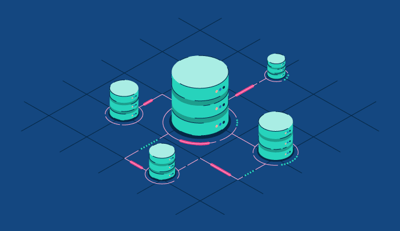July 11, 2025
 by Washija Kazim / July 11, 2025
by Washija Kazim / July 11, 2025
.png?width=690&name=G2CM_FI1016_Learn_Article_Images_%5Bcrypto_exchange%5D_V1b%20(1).png)
Traditional finance is built around institutions that control access, custody, and participation. DeFi removes those institutions and with them, the safety nets users have come to expect.
In 2025, decentralized finance platforms handle billions in daily transaction volume. They're not experimental; they’re live systems running stablecoin swaps, lending protocols, decentralized insurance, and DAO treasuries. But interacting with them isn't frictionless. Users absorb the risk, manage their own assets, and trust code instead of companies.
DeFi eliminates central intermediaries like banks by using smart contracts on public blockchains to execute financial transactions. Unlike traditional finance, users retain full custody of their assets, interact directly with protocols, and operate in permissionless systems without relying on institutional gatekeepers or approval processes.
The shift starts with custody. Unlike traditional finance, where a bank holds your funds, DeFi requires a cryptocurrency wallet to store and authorize every transaction. The wallet acts as your gateway to the entire ecosystem.
This guide examines DeFi's fundamentals from a more critical perspective: how it works, who it’s for, how to evaluate platforms, and the risks that still define the space. Whether you're ready to move funds or still on the fence, understanding the architecture and accountability model behind DeFi is non-negotiable.
Understanding DeFi starts with the architecture. These aren’t abstract crypto buzzwords — they’re systems you’ll interact with directly. If you're evaluating a protocol, you're also evaluating how it uses the following core components.
A blockchain is a distributed, immutable ledger that records transactions across a peer-to-peer network. It facilitates accurate transaction records without the need for an intermediary third party, such as a bank.
Every computer in a blockchain network holds a copy of the ledger to prevent data failure and ensure consistent and accurate records. While recording transactions is nearly immediate and transparent, the identification of senders and receivers is masked, simultaneously protecting the privacy of those in the system.
For a closer look at how blockchain is being used in other industries, check out these blockchain applications and examples.
Smart contracts are self-executing programs that define how assets move. In DeFi, they replace banks, escrow agents, and loan officers by automatically handling lending terms, interest calculations, or liquidation logic.
But they’re only as secure as the code, and once deployed, many can’t be altered. That makes contract audits and upgradeability a core part of risk evaluation.
Traditional contract execution often involves a third-party representative, such as a lawyer or a real estate agent, conducting negotiations and revising terms until both parties agree to the conditions listed. Instead, smart contracts attempt to reduce the risk and time required to use a third party while increasing efficiency and trust among parties.
DeFi runs on digital assets. Coins like ETH or BTC have their own blockchains, while tokens (like USDC or UNI) exist on top of them. Tokens serve different purposes: governance, staking rewards, collateral, or stable value.
Knowing which token you're interacting with and what it represents is key. Some tokens are backed by real assets, while others are purely speculative or governed by volatile incentives.
To understand how tokens can represent tangible assets like real estate or equities, explore what asset tokenization means in a blockchain context.
Protocols are the underlying rules and mechanisms that enable DeFi functions like trading, borrowing, or staking. Each protocol defines how assets are pooled, how yields are calculated, and how governance works.
As a user, choosing a protocol means committing to its logic. Whether you're depositing funds or borrowing against collateral, you're subject to how that protocol enforces risk and value.
dApps are the user interfaces built on top of protocols. They allow you to connect your wallet, authorize transactions, and interact with DeFi without writing code.
While the backend may be decentralized, the frontend still matters. A poorly designed dApp can obscure fees, misrepresent slippage, or present outdated token data, creating risk even in a well-audited protocol.
For a deeper look at how self-managed credentials are changing user access, read more about decentralized identity.
DeFi works by removing intermediaries and replacing them with code. Users interact with decentralized applications (dApps) that connect directly to smart contracts, programmed financial agreements deployed on a blockchain.
Here’s what that actually looks like in practice:
Example: Borrowing a stablecoin using DeFi
Let’s say you own ETH and want to borrow USDC without selling your assets.
This is just one example. The same model applies to DeFi swaps, staking, and yield farming. You authorize each action with your wallet, interact directly with protocols, and rely on smart contract code instead of human gatekeepers.
DeFi is built for autonomy, but that autonomy comes with trade-offs. Every transaction is final. Every signature carries risk. That’s why understanding how DeFi actually works matters before you move any funds.
Decentralized finance isn’t just a new way to transact — it’s an entirely different architecture for trust. That makes due diligence critical. Without a central authority to vet platforms for you, every user is effectively their own compliance officer. Before you lend, borrow, stake, or swap, here’s how to critically evaluate whether a DeFi platform is worth engaging with.
Any serious DeFi project should publish its smart contract code and undergo third-party audits. These audits aren’t a guarantee, but they signal maturity and a willingness to be scrutinized. Look for publicly available audit reports from reputable firms (e.g., Trail of Bits, OpenZeppelin). Some platforms will go further by publishing bug bounty programs or GitHub repos for ongoing community review.
What to look for: Recent audit reports, disclosed vulnerabilities (and how they were resolved), and ongoing update activity.
TVL refers to the total amount of crypto assets staked or deposited in a DeFi platform. While not a perfect metric, it’s a rough signal of how much capital the market trusts that protocol with. Spikes or drops in TVL can indicate growing popularity or sudden user exits due to risk events.
What to look for: Steady or growing TVL, consistent liquidity, and cross-chain support (if relevant to your use case).
Some DeFi platforms are community-governed via DAOs (decentralized autonomous organizations), while others retain centralized control over upgrades or treasury decisions. Understanding governance helps you gauge how change-resistant a platform is and whether a single actor can override core functions.
What to look for: Voting power distribution, documented proposals, and whether major updates require community approval.
No matter how robust a platform is, it has to work seamlessly with your wallet. That includes transaction clarity, support for hardware wallets, and smooth integration with popular browser extensions or mobile apps.
What to look for: MetaMask and WalletConnect support, mobile-friendly UX, low failed transaction rates, and integration with fiat on-ramps.
A well-run DeFi project usually fosters an active, helpful community across forums like Discord or X (formerly Twitter). Clear documentation and timely announcements aren’t just nice to have; they’re vital for onboarding, bug tracking, and transparency when things go wrong.
What to look for: Active moderation, user guides, published roadmaps, and fast responses during incidents.
DeFi isn't just novel. It offers structural benefits that change how users interact with financial systems. But those benefits aren’t automatic. They depend on what platforms you use, how much risk you accept, and how prepared you are to self-manage.
In 2024, Fast Company reported that roughly six million people in the U.S. and more than one billion people outside the U.S. don’t have a bank account. This lack of connection to a bank or financial institution can limit their access to products and services, especially when the seller or provider doesn’t accept cash.
DeFi doesn’t require a bank account, credit score, or approval. If you have a crypto wallet and internet access, you can lend, borrow, or trade globally. This is especially meaningful in regions with unstable currencies or limited banking access, but it also applies to users who prefer financial autonomy over institutional control.
Many people consider decentralized finance a viable alternative because DeFi systems are cheaper than their traditional counterparts. Conventional financial systems rely on intermediaries like banks and brokers, both service providers that charge fees.
Smart contracts automate what banks and brokers typically charge for. Most protocols operate with transparent, flat fees; no hidden spreads or surprise markups. That said, network gas fees, slippage, and liquidity issues can make DeFi just as expensive if you don’t time your transactions right.
Banks and other financial institutions hold and manage user funds in traditional finance. If a user wants to make a transaction, lend, or borrow money, they must do so with oversight from these intermediaries. While instilled to protect parties, this process can feel restrictive and limit user control, particularly when they don’t qualify to borrow money.
Those taking part in a DeFi system have complete control over their assets and financial decisions. They can make transactions, lend, and borrow what they want on their terms by accessing their secure wallet rather than seeking approval or permission from a central authority. This level of autonomy fosters individual ownership and responsibility for financial decisions without dictated terms.
Finally, blockchain technology offers greater transparency into transaction history by recording it on a public ledger where users can audit and verify activities. Given the public ledger, users can see fund history and management, increasing transparency for every user in the system. From a security standpoint, since DeFi relies on smart contracts that execute automatically upon meeting conditions, there’s a reduced chance of unintended human error and fraudulent transactions.
DeFi offers many potential benefits in challenging traditional finance practices, but it also presents risks and challenges worth understanding before taking part, including:
One of the biggest hurdles DeFi faces is the lack of clear regulatory frameworks. Since these systems operate outside of traditional frameworks, situations may fall into gray areas where regulations don’t exist or might only partially apply. Globally, regulatory bodies continue to strive toward constructing a regulatory landscape that supports DeFi's goals.
For example, the U.S. Securities and Exchange Commission (SEC) said, “In the United States, multiple federal authorities likely have jurisdiction over aspects of DeFi, including the Department of Justice, the Financial Criminal Enforcement Network, the Internal Revenue Service, the Commodity Futures Trading Commission, and the SEC.” However, the phrase “likely have jurisdiction” is vague and unclear, creating confusion for users and businesses alike.
Georg Lorenz, Attorney interviewed businesses, regulators, and venture capital investors about DeFi and said, “My main empirical findings are that there is consensus among the interviewees that DeFi creates numerous risks that must be regulated, and that regulatory clarity is crucial for DeFi to thrive.”
These statements highlight that uncertainties and anxiety around a lack of regulatory guidance are common in the DeFi industry. Until regulators establish more concrete guidelines, the lack of clarity could deter new users and stifle innovation.
Traditional finance offers protection, like deposits (with the potential for refunds) and purchase insurance. Credit card companies, for example, offer chargeback mechanisms that protect users from unauthorized transactions.
In contrast, DeFi requires users to take full responsibility for their funds. If assets are stolen through fraud or hacking, there’s often no recourse to recover them. Without centralized protections, users must exercise extreme caution and adopt best practices for securing their wallets and funds.
While smart contracts reduce human error and fraud risks, they are vulnerable to malicious hackers. Smart contracts with vulnerabilities could enable hackers to steal user funds with little to no protection provided to the victim. Cybercriminals plague the cryptocurrency industry. According to Tyler Pearson for DLNews, 69 hacks in 2023 cost crypto companies and DeFi protocols over $735 million.
Volatility is a defining characteristic and deterrent of decentralized finance. Token prices can rapidly and significantly fluctuate, creating enticing profit potential and the simultaneous risk of substantial losses. Those who partake must determine their risk tolerance to decide what they feel comfortable with while understanding that market conditions are outside their control.
Somewhat. But users still shoulder most of the risk. While DeFi protocols today are more likely to undergo third-party audits, those audits aren’t a guarantee. Several platforms exploited in 2023 had already been audited, but missed follow-ups or ignored flagged issues.
According to DLNews, 69 hacks last year cost DeFi platforms more than $735 million. Community scrutiny has improved, but vulnerabilities still slip through.
Decentralized finance promises direct access, financial autonomy, and borderless participation, but that doesn’t mean it’s a universal fit. While DeFi removes institutional gatekeepers, it places greater responsibility on the individual.
Understanding whether DeFi aligns with your goals, risk tolerance, and technical comfort can help you avoid avoidable losses and misplaced expectations.
You’re not just interested in holding crypto, but actively want to participate in financial protocols: earning yields, voting in governance proposals, or trading peer-to-peer. DeFi can be compelling if:
Before using any protocol, it's worth simulating transactions with small amounts or in testnets to understand how things behave in practice.
Jumping into DeFi without preparation often leads to user error, not protocol failure. If any of the following apply, it’s worth slowing down:
DeFi opens doors but also removes nets. Knowing when you're ready (and when you're not) is part of the responsibility that comes with decentralization. This space rewards caution, independent thinking, and a long-term approach far more than hype-driven action.
Decentralized finance (DeFi) is an emerging financial technology that challenges traditional and centralized standards. Its goal is to eliminate intermediaries and create decentralized, transparent financial systems for everyone involved.
While it offers better accessibility, more user control, and increased transparency, it also presents unique challenges like regulatory uncertainty and security concerns. As the world of DeFi grows, staying on top of the latest information and trends can help you decide whether it’s the right financial move for you.
Are you curious about which cryptocurrency types are popular in the market? Here’s what we found.
Washija Kazim is a Sr. Content Marketing Specialist at G2 focused on creating actionable SaaS content for IT management and infrastructure needs. With a professional degree in business administration, she specializes in subjects like business logic, impact analysis, data lifecycle management, and cryptocurrency. In her spare time, she can be found buried nose-deep in a book, lost in her favorite cinematic world, or planning her next trip to the mountains.
Even now that the dust surrounding it settled down a bit and Initial Coin Offering (ICO)...
 by Hristina Nikolovska
by Hristina Nikolovska
When most people hear the word “blockchain,” the first and only thing that usually comes to...
 by Bryce Welker
by Bryce Welker
You probably know blockchain is the technology behind Bitcoin, Ethereum, and other...
 by Soundarya Jayaraman
by Soundarya Jayaraman
Even now that the dust surrounding it settled down a bit and Initial Coin Offering (ICO)...
 by Hristina Nikolovska
by Hristina Nikolovska
When most people hear the word “blockchain,” the first and only thing that usually comes to...
 by Bryce Welker
by Bryce Welker


